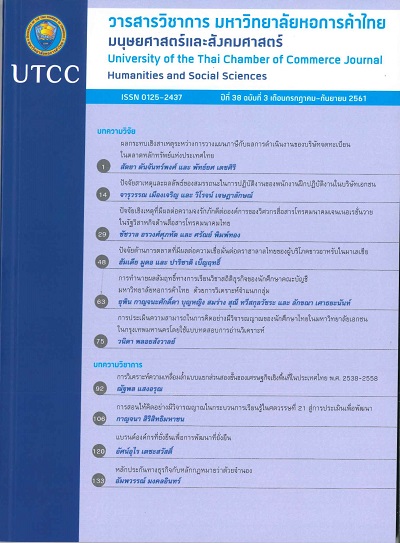Two-Stage Inequality Decomposition Analysis of Thailand’s Spatial Economy, 1995–2015
Main Article Content
Abstract
This study analyses spatial economic inequality in Thailand over the period of 1995-2015
using two-stage inequality decomposition analysis to divide the levels of spatial inequality: betweenregion
inequality, between-provincial cluster inequality and within-provincial cluster inequality.
The analysis shows that overall inequality has decreased particularly since 2007 which
performed by the declination of between-region inequality. On the other hand, between-provincial
cluster inequality has increased which means when the trend of overall inequality is downward,
another inequality occurs. This situation reflects on the spatial agglomeration of economic activities,
it has also found in the level of within-provincial cluster inequality. Therefore, the further spatial
economic development policy should deeply emphasize the development in the levels of provincial
cluster and province and also integrate with the other perspectives of development.
Article Details
ลิขสิทธิ์ของบทความ
ผลงานที่ได้รับการตีพิมพ์ถือเป็นลิขสิทธิ์ของมหาวิทยาลัยหอการค้าไทย ห้ามมิให้นำเนื้อหา ทัศนะ หรือข้อคิดเห็นใด ๆ ของผลงานไปทำซ้ำ ดัดแปลง หรือเผยแพร่ ไม่ว่าทั้งหมดหรือบางส่วนโดยไม่ได้รับอนุญาตเป็นลายลักษณ์อักษรจากมหาวิทยาลัยหอการค้าไทยก่อน
References
nested theil decomposition method. Annals of Regional Science, 37, 55-77.
Chansarn, S. (2012). Situation regarding poverty and income inequality in Thailand. Executive Journal, 32(1), 3-10.
(in Thai).
Jitsuchon, S. (2015). Inequality in Thai society: Trend, policy and policy implementation. Bangkok, Thailand: Thailand Development Research Institute. (in Thai).
Kmonwatananisa, N. (2008). Thailand’s management of regional and spatial development. Bangkok, Thailand: Office of National Economic and Social Development Board.
Limpanonda, S. (2012). Provincial disparities in Thailand: Convergence, agglomeration economies and effects on poverty, 1988‐2008. London, United Kingdom: University of London.
Marquez, M. A., & Lasarte, E. (2014). Decomposition of regional income inequality and neighborhood component: A spatial theil Index. Valencia, Spain: Valencian Institute of Economic Research.
Office of National Economic and Social Development Board. (2017). Analytical report on poverty and inequality situations in Thailand. Bangkok, Thailand: Author. (in Thai).
Preechametta, A. (Ed.). (2016). Regional inequality in Thailand. Bangkok, Thailand: Thammasat University Printing House.
Ratanawaraha, A. (2009). Spatial inequality in Thailand, 1981 – 2005: Discussion paper 2009-1. Bangkok, Thailand: Chulalongkorn University, Faculty of Architecture, Department of Urban and Regional Planning. (in Thai).
Sarntisart, I. (2000). Growth, structural change and inequality: The experience of Thailand. Helsinki, Finland: UNU World Institute for Development Economic Research.
Tinakorn, P. (2002). Income inequality in four decades of development: 1961–2001. Thammasat Economic Journal, 20(2–3), 141–208. (in Thai).
Wisaweisun, N. (2009). Spatial disparities in Thailand: Does government policy aggravate or alleviate the problem?. In Reshaping economic geography in East Asia (pp. 184–194). Washington, DC: The World Bank.
Wongniyomkaset, W. (2014). Policy formulation for the purpose of decreasing spatial inequality. King Prajadhipok’s Institute Journal, 12(2), 31–51. (in Thai).


